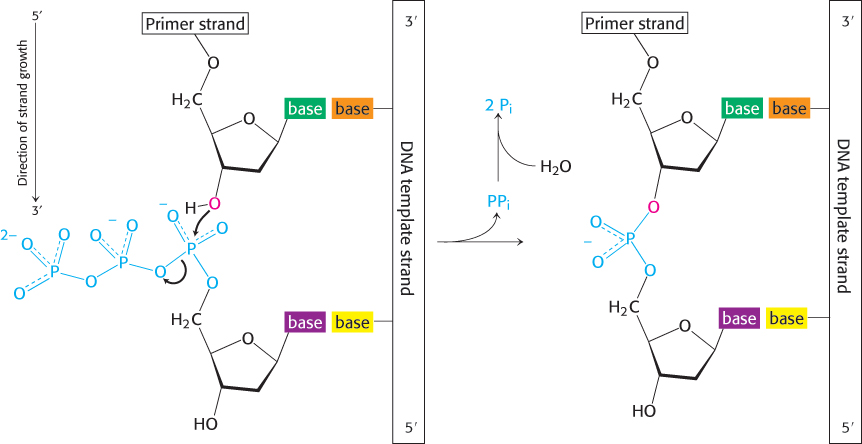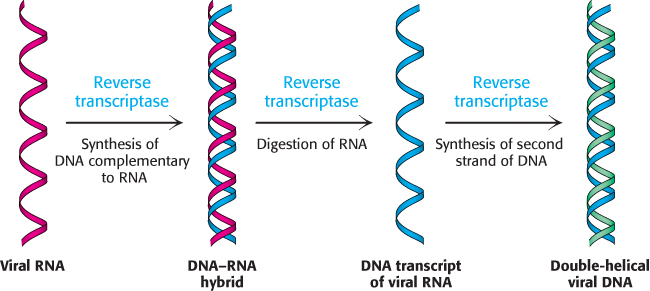4.4 DNA Is Replicated by Polymerases That Take Instructions from Templates
We now turn to the molecular mechanism of DNA replication. The full replication machinery in a cell comprises more than 20 proteins engaged in intricate and coordinated interplay. In 1958, Arthur Kornberg and his colleagues isolated from E. coli the first known of the enzymes, called DNA polymerases, that promote the formation of the bonds joining units of the DNA backbone. E. coli has a number of DNA polymerases, designated by roman numerals, that participate in DNA replication and repair (Chapter 28).
DNA polymerase catalyzes phosphodiester-bridge formation
DNA polymerases catalyze the step-by-step addition of deoxyribonucleotide units to a DNA strand (Figure 4.24). The reaction catalyzed, in its simplest form, is
where dNTP stands for any deoxyribonucleotide and PPi is a pyrophosphate ion.

Figure 4.24: Polymerization reaction catalyzed by DNA polymerases.
DNA synthesis has the following characteristics:
1. The reaction requires all four activated precursors—that is, the deoxynucleoside 5′-triphosphates dATP, dGTP, dCTP, and TTP—as well as Mg2+ ion.
2. The new DNA strand is assembled directly on a preexisting DNA template. DNA polymerases catalyze the formation of a phosphodiester linkage efficiently only if the base on the incoming nucleoside triphosphate is complementary to the base on the template strand. Thus, DNA polymerase is a template-directed enzyme that synthesizes a product with a base sequence complementary to that of the template.
3. DNA polymerases require a primer to begin synthesis. A primer strand having a free 3′-OH group must be already bound to the template strand. The chain-elongation reaction catalyzed by DNA polymerases is a nucleophilic attack by the 3′-OH terminus of the growing strand on the innermost phosphorus atom of the deoxynucleoside triphosphate (Figure 4.25). A phosphodiester bridge is formed and pyrophosphate is released. The subsequent hydrolysis of pyrophosphate to yield two ions of orthophosphate (Pi) by pyrophosphatase helps drive the polymerization forward. Elongation of the DNA chain proceeds in the 5′-to-3′ direction.

Figure 4.25: Strand-elongation reaction. DNA polymerases catalyze the formation of a phosphodiester bridge.
[Source: J. L. Tymoczko, J. Berg, and L. Stryer, Biochemistry: A Short Course, 2nd ed. (W. H. Freeman and Company, 2013), Fig. 34.2.]
4. Many DNA polymerases are able to correct mistakes in DNA by removing mismatched nucleotides. These polymerases have a distinct nuclease activity that allows them to excise incorrect bases by a separate reaction. This nuclease activity contributes to the remarkably high fidelity of DNA replication, which has an error rate of less than 10−8 per base pair.
The genes of some viruses are made of RNA
Genes in all cellular organisms are made of DNA. The same is true for some viruses but, for others, the genetic material is RNA. Viruses are genetic elements enclosed in protein coats that can move from one cell to another but are not capable of independent growth. A well-studied example of an RNA virus is the tobacco mosaic virus, which infects the leaves of tobacco plants. This virus consists of a single strand of RNA (6390 nucleotides) surrounded by a protein coat of 2130 identical subunits. An RNA polymerase that takes direction from an RNA template, called an RNA-directed RNA polymerase, copies the viral RNA. The infected cells die because of virus-instigated programmed cell death; in essence, the virus instructs the cell to commit suicide. Cell death results in discoloration in the tobacco leaf in a variegated pattern, hence the name mosaic virus.
Another important class of RNA virus comprises the retroviruses, so called because the genetic information flows from RNA to DNA rather than from DNA to RNA. This class includes human immunodeficiency virus 1 (HIV-1), the cause of acquired immunodeficiency syndrome (AIDS), as well as a number of RNA viruses that produce tumors in susceptible animals. Retrovirus particles contain two copies of a single-stranded RNA molecule. On entering the cell, the RNA is copied into DNA through the action of a viral enzyme called reverse transcriptase, which acts as both a polymerase and an RNase (Figure 4.26). The resulting double-helical DNA version of the viral genome can become incorporated into the chromosomal DNA of the host and is replicated along with the normal cellular DNA. At a later time, the integrated viral genome is expressed to form viral RNA and viral proteins, which assemble into new virus particles.

Figure 4.26: Flow of information from RNA to DNA in retroviruses. The RNA genome of a retrovirus is converted into DNA by reverse transcriptase, an enzyme brought into the cell by the infecting virus particle. Reverse transcriptase possesses several activities and catalyzes the synthesis of a complementary DNA strand, the digestion of the RNA, and the subsequent synthesis of the DNA strand.



